Perinatal period generally refers to 21 days before delivery to 21 days after delivery, of which the first 3 weeks are pre-period and the latter 3 weeks are post-perinatal. The perinatal period is a crucial period in the dairy cow's entire lactation cycle. During this period, the cow experiences tremendous physiological and metabolic changes, as well as a series of stress, such as labor, lactation, changes in dietary structure, environmental changes, etc. All have a great influence on the health of dairy cows. Therefore, the success of broiler husbandry management and health care determines the performance of dairy cows throughout the lactation period and the economic benefits of pastures. The following will mainly describe dairy cows in the pre-period and post-perinatal management and how to care.
Early dry milk (dry milk until 21 days before delivery)
This is an important part of the dairy cow's feeding and management process, which is conducive to embryonic development, promotes the restoration of breast function, and is beneficial to the recovery of the cow's constitution.
Feeding management
The diet should be dominated by coarse materials, and the root and blue-green materials should be properly controlled. The amount of concentrate should be adjusted according to the quality and condition of the coarse materials, generally between 3 kg and 4 kg, and the DMI should account for 1.8%-2.5% of BW, which is generally 11%. Kilograms ~ 12 kilograms, roughage accounted for DM60% ~ 95%, long roughage accounted for DM10% ~ 20%, crude protein accounted for DM12% ~ 13%. The formulation of feeding programs should take corresponding measures based on the results of body posture scoring. During the dry period, the growth of the fetus is rapid, and the intake of the fine material of the cow should be strictly controlled so as to prevent the fetus from being oversized and causing dystocia.
health care
Dry milk period is the best time for dairy cattle tissue repair. During this period, the dairy cows' health care work will have a multiplier effect in reducing the incidence of postpartum mastitis.
Dry milk operation
Two weeks before dry milk, cows with dry milk are tested for hidden mastitis in Shanghai, and cows with a rating of “++†or higher are treated. Conditioned milk samples can be collected for bacterial identification and drug susceptibility testing, and targeted treatments are conducted. When dry milk is carried out according to normal procedures: milk is squeezed out → teat is sterilized → dry milk drug closes the nipple.
Dry milk care
After dry milk, arrange a person to observe and check the changes of the cow's breast every day. The cows with mastitis were found to be treated promptly, and after the cure, they were re-sealed. In the early stage of dry milk, do a good job of deworming and trimming the limbs and hooves, keep the cow bed clean and dry, and regularly disinfect.
Perinatal period (21 days before delivery)
Feeding management
The pre-perinatal dairy cows mainly rely on the transition of diets to increase the concentration of diets, so that cows gradually adapt to postpartum high-concentrate feeding methods and reduce the incidence of postpartum metabolic diseases. The type of diet is the same as that of the perinatal period, and avoid the use of buffers such as baking soda to control the salt. During pre-period feeding, diets should be kept low calcium levels (daily intake of less than 50 grams), can also be added to prevent the occurrence of postpartum hypocalcemia by adding anion salts, increase the content of vitamin E and selenium to reduce the postpartum placental retention Disease has a certain role.
Delivery room is an important place for dairy cows to be born and yak is born. The management of the delivery room is an important task to meet the new lactation period of cows and ensure the survival rate of yaks.
Creating a comfortable environment The delivery room should be kept quiet, dry and tidy, and well ventilated. For changing litter, cow mattresses should be replaced at least once every two days, and yak cages should be replaced daily. Prepare 1 to 2 natural delivery rooms (around 20 square meters) depending on the size of the dairy farm.
Natural births promote natural births, and cows who have signs of childbirth should be rushed into the delivery room. Observe the clinical cows and give drinking water and quality roughage. In the event of a simple fetal malposition, it can be delivered naturally after a simple midwifery. The body of the newborn calf is mucous until the cows have dried and moved to the yak cage.
health care
Sterilize the cow bed, dung ditch, and the excreta after each milking, and clean it in time, clean it and disinfect it. In the natural delivery room, litter and other contaminants should be cleaned immediately after the new breed of cattle is removed, cleaned and rinsed and disinfected. In the peak season of calving, the frequency of disinfection at the stadium should be increased to once a month. Newborn calves must disinfect the umbilical cord with 5% to 10% iodine when they move into yak cages. After the yak is removed, the yak cage should be cleaned and replaced with fresh litter.
Cows with midwives who are having difficulties with natural delivery should immediately undergo artificial labor. The midwife prepares the midwifery equipment and dispenses the disinfecting medicine. The midwife carefully disinfects the operator's arm, the cow's genital area, and the midwifery equipment before midwifery. After the end, all the equipment is cleaned, disinfected, dried, and used. Check the birth canal and fetus of the cow and make an accurate judgment as soon as possible. According to the cow's responsibilities to pull the fetus, you can't use too much force. After the cows are divided, they should drive the cows to stand, which can reduce bleeding in the birth canal and prevent the occurrence of uterine ectropion and postpartum nerve palsy.
Late perinatal period (21 days after childbirth)
Feeding management
In the post-perinatal period, dairy cows are mainly responsible for relieving the negative balance of energy, supplying the highest quality coarse material and restoring the body condition as soon as possible. Cows have low feed intake during the postpartum period and therefore should provide high-concentration diets with energy levels of 1.70 megakascals to 1.75 megakalps per kilogram, and crude protein levels can be increased to 18%. The addition of a certain amount of fat powder has the effect of relieving the negative balance of energy, but the controlled dosage is within 350 grams. Due to the high amount of concentrate in the diet, the buffering agent baking soda 100 grams to 150 grams, magnesium oxide 30 grams to 50 grams.
health care
The health care of dairy cows during the post-perinatal period is mainly based on new breeds of cattle. Newly-produced cattle are weak in the post-natal period, and if the disease occurs, the process is very fast. It is necessary to strengthen the nursing and monitoring from the following aspects to ensure that it will be put into production as soon as possible.
Appetite and appetite can directly reflect the apparent characteristics of the cattle body and need to be monitored. Observe dairy cows that exhibit depression. They may develop symptoms of inapparent milk fever, ketosis, and other postpartum disorders.
The body temperature of postpartum bovine newborns with body temperature is most likely to be due to inflammation in the birth canal and mammary glands. However, due to the difference in individual resistance, some newly born cattle have normal appearance characteristics of inflammation, and cows within 1 week of new production need to be performed. Temperature monitoring to achieve "early detection and early treatment" purposes.
Uterine cows should be fed with Motherwort immediately after giving birth in order to restore the uterus. Observe the physical status and odor of the uterine discharge. For example, cows that have retained the placenta and have poor lochia must be vaccinated with antibiotics, if necessary, combined with systemic treatment.
Breast on the new production of cattle mastitis should pay attention to the difference between breast edema and breast swelling, colostrum and mastitis milk. Treatment for new-born bovine mastitis should increase the number of injections of the drug twice a day, combined with systemic treatment.
Treatment of Newly Produced Cattle With Medications For the first time, antibiotics with fast blood peaks and short half-lives may be used, and the dose may be increased as appropriate. Measurements of body temperature, heart rate, respiration, etc. before intravenous injection. Dexamethasone and other hormone drugs are used with caution. Poorly bred cows can be supplemented with high sugar and high salt to enhance nutrition and appetite.
Cows in the late perinatal period are susceptible to the following diseases:
Chest fever (postpartum paralysis)
It is a severe metabolic disease that occurs suddenly after delivery in dairy cows. With loss of consciousness and quadriplegia as the main features, especially high-yielding dairy cows with 3 to 6 fetuses with good nutrition have a high incidence of disease. They often develop within 3 days after childbirth. The origins of breast fever are mainly due to calcium absorption dysfunction, and pre-natal dry periods. The use of high-calcium and low-phosphorus diets, postpartum calcium excreted in large amounts with the milk, blood calcium can not be promptly added to the body's rapid decline in blood calcium, and vitamin D deficiency and other causes.
The main prevention is feeding low-calorie diets during the dry period, which stimulates the secretion of parathyroid hormone to maintain its active state.
Treatment of commonly used calcium preparations intravenously, such as calcium gluconate, calcium chloride. The calcium injection should also relieve the irritating effect on the heart. When calcium chloride is injected into the blood vessels outside the blood vessels, it can easily cause tissue necrosis. Physiotherapy has a breast delivery to increase the intra-mammary pressure, reduce blood flow, and reduce breast blood calcium loss. For the high-yielding dairy cows, milk output is controlled within 1 week after delivery, and vitamin A, vitamin D, and vitamin E preparations are given 1 week before delivery, and the intramuscular injection until delivery is beneficial to the metabolism of calcium.
Ketosis
It is caused by the negative balance of energy in dairy cow's nutrient metabolism, and the decrease of blood glucose concentration is the main reason for the occurrence of ketosis. The main mechanism is that the concentrate feeds too much, the crude fiber is insufficient or the prenatal and postpartum feed intake decrease, causing indigestion, the volatile fatty acid in the cow is reduced, and the carbohydrate supply in the feed is insufficient, so that the blood glucose concentration in the body is decreased. Increased production of ketones, ketoacidosis, ketouria, or keto-coeliac disease, collectively known as ketosis. The disease occurs in 10 to 60 days after the calving of high-yield dairy cows, and the incidence of high-yielding cows is high among 3 to 6 births. Although ketosis rarely causes death, it can cause health problems such as a decrease in the reproductive rate of cows, endocrine hormone disorders, and limb and foot disease.
Prevention is mainly to ensure the nutritional balance of dairy cows during the dry period and to reduce the negative balance of energy as much as possible.
The most common method of treatment is intravenous injection of 50% glucose 500 ml, oral propylene glycol 300 ml, 1 to 2 times a day for 1 to 5 consecutive days.
Tire retention
Cows do not discharge the tires after 8 to 12 hours postpartum, which means that they are stranded. There are many causes of the retention of the placenta, which is mainly related to postpartum uterine contractility, inflammation of the placenta during pregnancy and the placental structure of the cow.
Prevent and improve cow feeding and management, feed with rich vitamins and trace elements; increase exercise and grazing time; after delivery, let cows dry mucus on yak body and milk as early as possible to promote pituitrin release. Immediately after delivery, calcium gluconate solution can be injected, or motherwort syrup can be fed, which also has the effect of preventing the retention of the placenta.
Treatment of dairy cows after intramuscular injection of oxytocin or subcutaneous injection of diethylstilbestrol or estradiol benzoate promotes uterine contraction; infusion of hypertonic saline into the uterus of cows stimulates uterine contractions and promotes shrinkage of the placenta and shedding. When drug therapy is ineffective, surgical dissection can be performed before the cervical opening has been reduced. Before peeling the surgeon arm strict disinfection; peeling should pay attention to the action should be light, can not be forced to peel, so as not to damage the uterus caused by infection; peeling after the uterus should not be washed, the antibiotic can be placed in the uterus. Observe the presence of uterine inflammation and systemic symptoms in the affected cows.
Manual Operating Table
This operation manual table is widely used in operating rooms in hospital and clinics. The manual Operating Table is suitable for surgery operations on body parts head, neck, chest, abdominal cavity, perineum and extremities. And for wide general surgeries, obstetrics and gynecology, ENT, orthopedics and other surgical use.
The manual Surgical Table can be adjusted flexibly like table up and down, backboard folding up and down, head board folding up and down, leg board folding down, tabletop lean left and lean right, tabletop lean forward and backward by the foot pedal pump and the manual hand wheels.
Matrial of the whole structure is stainless steel.
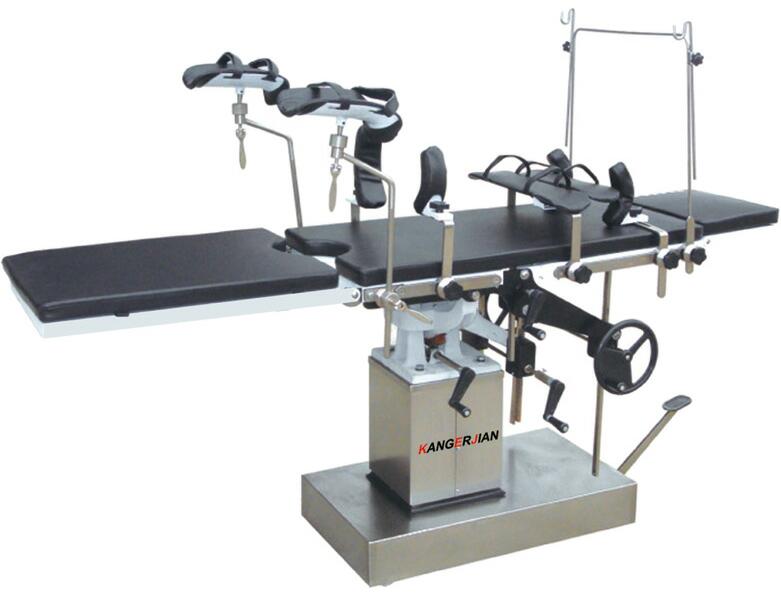
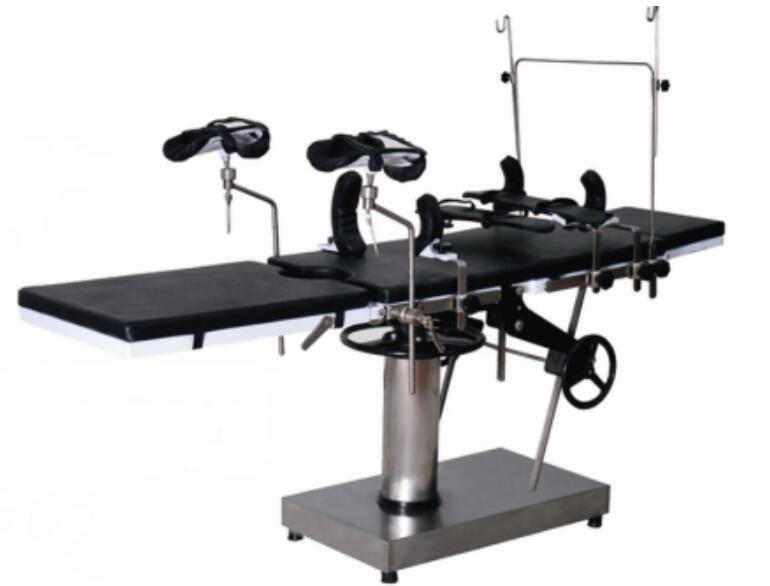
Certificates
Certificates of CE, ISO9001, ISO13485, CFDA are approved.
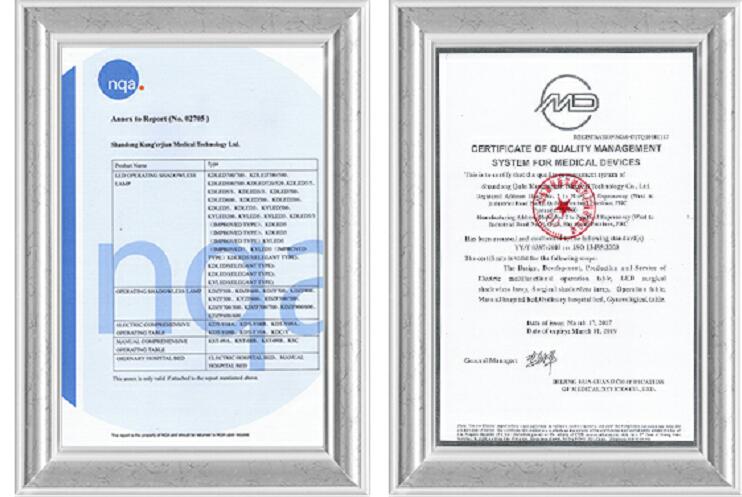
Company
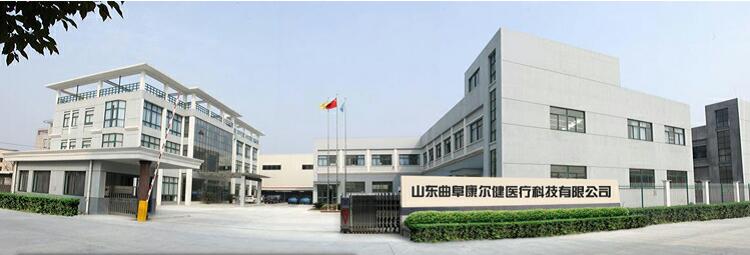
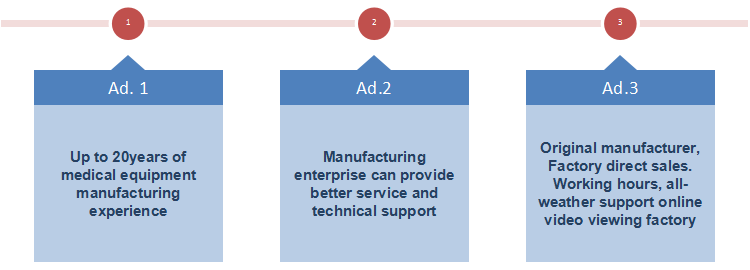
Shangdong province is the main machinery production base in China.
KANGERJIAN Medical Technology Co., Ltd. is a group of senior lighting design expert and machinery manufacturing expert company with 20years experience and factory locating in the east city--the hometown of confucius--Qufu in Shandong province, China.
The Company has passed the ISO:9001:2008 quality system certification, ISO13485:2003 quality system certification, CE certification and CFDA certification, so that the enterprise management standards and product quality is relatively connected to expand the international market for enterprises to lay the foundation.
Our main products: Operation Theatre Lights , Operating Room Lights , Halogen Operating Light , LED Operating Light , Surgical Operating LED Light , LED Examination Light , Mobile Type Operating Light , Gynecology Examination Tables , Obstetric Delivery Bed , Electrical Gynecological Table, Obstetric Delivery Table , Delivery Examination Table , Electric Hydraulic Operating Table, Electric Medical Operating Table, Manual Electric Operating Table, Surgical Table, Operating Table, Operating Theatre Pendants , icu tower crane in ICU room, LED Viewbox etc. professional medical equipment.
KANGERJIAN Team
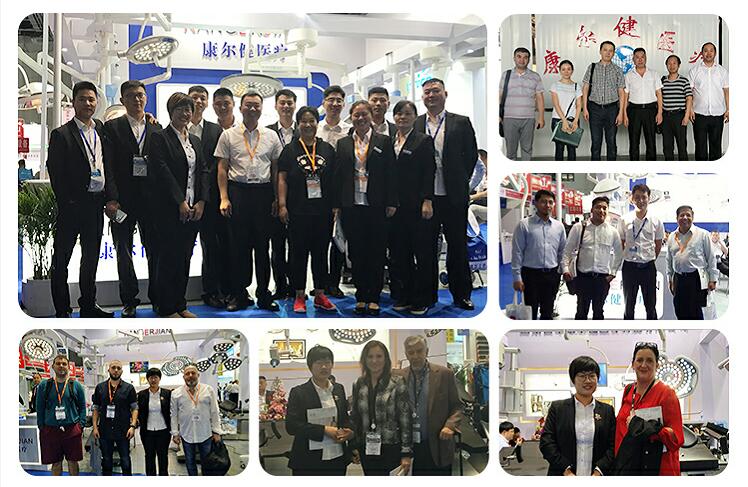
Package:
Inner Package---Dust-proof plastic film+ qualified shockproof foam
Outer Package---Thick Plywood case for over sea delivery
We support ODM of the package if there's special demands from clients
Shippment:
Sea shipping, Air transportation, Expresses like DHL, UPS FEDEX, TNT etc. Our forwarder give good price support.
Clients also can choose their own forwarder.


Manual Operating Table
Manual Operating Table,Manual Electric Operating Table,Manual Gynecological Operating Table,Manual Universal Operating Table
Shandong Kang'erjian Medical Technology Ltd. , https://www.operatingtable.nl
